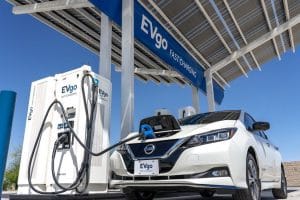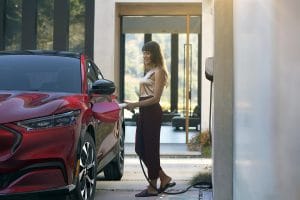
Public charging stations are popping up across the country but motorists still may need some help finding them.
There are three sizable roadblocks to broad public acceptance of electric vehicles: cost, range, and the availability of public charging stations – but all three obstacles are beginning to crumble. With battery costs dropping fast, next-generation EVs are starting to come down in price, even as their range continues to grow.
The issue of public charging could be a bit trickier in a country stretching nearly 3,000 miles, coast-to-coast, but the number of charging stations is beginning to rise at an almost exponential rate. And, in the process, finding those already in operation is becoming increasingly easy.
Google is the latest to weigh in. The online service first made it possible to locate chargers last October with an update to its Google Maps app. Now, it is going a useful step further. The latest tweaks also allow you to determine whether an EV stations has the right type of plug for your vehicle, how fast it operates and whether the charger is in use or available.
(GM “on track” to meet 20 EV target by 2023)
The reality is that it will take quite some time before plugging in using public charging stations becomes as easy as filling up a gas tank. There are a total of 168,000 retail gas stations in the U.S., according to EPA data. As the year began, there were just 20,000 public charging stations with 57,000 individual chargers, reported statista.com.
 But the figure is fast on the rise, with hundreds of stations going into operation each month. By mid-year, meanwhile, the number of individual chargers was estimated to have grown to 68,000. Of those, about 16% are Level 3 “quick chargers” that can yield as much as an 80% battery top-off in as little as 20 minutes, depending upon their power rating and the capabilities of each specific vehicle.
But the figure is fast on the rise, with hundreds of stations going into operation each month. By mid-year, meanwhile, the number of individual chargers was estimated to have grown to 68,000. Of those, about 16% are Level 3 “quick chargers” that can yield as much as an 80% battery top-off in as little as 20 minutes, depending upon their power rating and the capabilities of each specific vehicle.
Experts note that the vast majority of charging is done at home or office – and likely will continue – but that doesn’t help when EV owners have to clock extra miles for work or are simply heading out on a long vacation drive.
The good news is not only the increasing number of chargers but the fact that they’re more and more often placed in convenient locations allowing a driver to do something other than sit in their vehicle waiting for the battery to charge back up.
Thousands of new chargers have been placed by coffee shops, supermarkets, WalMart superstores and similar venues. With a Level 3 system, an EV would likely have its pack completely topped off by the time the driver is ready to get back on the road.
Even with the rising number of EV charging stations, however, it can be challenging to find one when needed. Many are tucked away in locations you might not readily spot driving by – unlike well-marked gas stations. So, having a way to track chargers down can be critical.
Many of today’s battery-cars are equipped with navigation systems that feature apps that can locate nearby chargers. In some cases, they’ll even plot out a route that may take you slightly out of the way but which will ensure you always stay within range of chargers along the way.
Because EVs can’t charge up nearly as fast as a gas-powered vehicle can fill its tank, individual chargers can be tied up for quite some time. Some charging station trackers will tell you if the system is currently in use. Electrify America’s latest app even can indicate how long it likely will be before the charger is freed up again.
(Americans now buying more EVs than cars with manual transmissions)

Most EV owners charge at home or office, something likely to continue. But public chargers will be critical to extend the range EVs can travel.
The latest Google Maps update also fills in another gap, advising you as to what sort of plug, or plugs, are available. There are four different common plug types currently in use:
· Level 2 plugs, which rely on 240-volt power and can require a vehicle to plug in for hours, are generally found on most EVs;
· The CHAdeMO plug is unique to Nissan and Mitsubishi vehicles and is not nearly as common as
· The CCS quick-charge plug used by virtually every other manufacturer. CCS plugs can handle anything from 50 to 350 kilowatts of power;
· Tesla uses its own proprietary plug at its Supercharger locations but it also offers adaptors allowing owners to tap into chargers with CCS and CHAdeMO plugs.
Finding an EV charging station is, on the whole, becoming increasingly easy – though that depends on where you might be traveling. According to Green Car Congress, about a third of the chargers in operation by mid-2019 were located in California, which also happens to be the state with the highest EV sales. It noted that there were 18 other states that had at least 1,000 Level 2 and fast chargers in operation.
(Maryland gas station swaps gas pumps for EV chargers)
Things can get a bit more challenging in the U.S. heartland, however, with a relative handful of chargers in places like Wyoming and the Dakotas. More are popping up along main, cross-country routes, such as Interstates 80 and 90, but it will likely be years before public chargers become near as ubiquitous as gas stations, at least in the middle of the country, experts caution.
